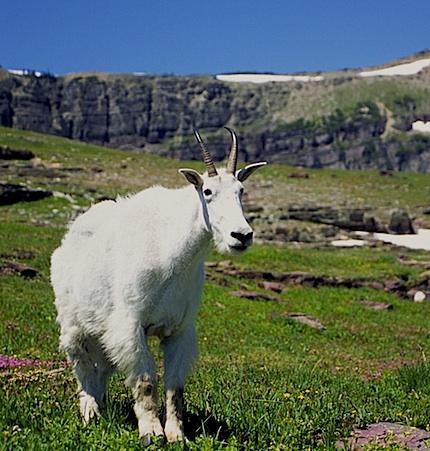A long-term research project into mountain goats and humans is expected to begin later this summer in Glacier National Park, where researchers want to better understand how the goats are impacted by people, cars, and infrastructure.
The research, being conducted by park staff in partnership with the University of Montana, is to study how mountain goats are affected by roads, people and trails in the Logan Pass area. The research is a critical component of the current Going-to-the-Sun Road Corridor Management planning effort, as human-wildlife interactions within the corridor is an identified issue of concern, park officials said in a release.
Interactions between humans and goats are increasing in the Logan Pass area, creating potential unhealthy, unnatural and unsafe conditions.
Acting Glacier National Park Superintendent Kym Hall said, “Our existing knowledge about mountain goats in the park is very limited and not sufficient on which to make management decisions.”
An incident in Olympic National Park has also prompted park managers to seriously research this issue. In 2010 there was a visitor fatality that was a direct result of an interaction with a mountain goat.
Supterintendent Hall said the mission of the National Park Service includes protecting the wildlife and providing for the enjoyment of them in such a way that will leave them unimpaired for the enjoyment of future generations. She believes this study, with its combination of methods, strategies, sample size, focused study area and limited duration, is an attempt to balance the park’s need to develop long-term and science-based management strategies for the Logan Pass area and the Going-to-the-Sun Road Corridor while at the same time providing a quality visitor experience that celebrates the park’s wildlife.
The mountain goat is a recognized iconic and historic symbol of the park. Superintendent Hall said that park managers have discussed the study and believe that the research plan will allow for the gathering of valuable data, while managing goat and human safety as the top priority.
Specific goals of the project include an understanding of:
•Individual goat use of Logan Pass and adjacent areas and movements on the landscape,
•Goats and humans in close proximity to each other and possible deterrents,
•Goat concentrations and unnatural behavior,
•Goat use of roads, developed areas and proximity to people as safe havens from predators, and
•Productivity estimates of females.
The study will incorporate observational, collaring, messaging and marking techniques. Researchers will spend time observing and recording human-goat interactions. Informational signs about human-goat interactions will be placed in the Logan Pass area.
Approximately 20-25 of the park's estimated 1,500 mountain goats will be collared for the study. A few goats that will not be able to be collared may be temporarily marked to enable a researcher to visually distinguish between individual goats.
Research on bighorn sheep will be conducted simultaneously, with observational, messaging and marking techniques. No collars will be placed on bighorn sheep, as individual sheep are easier to identify due to horn variations.
The project is anticipated to begin later this summer with National Park Service employees overseeing and conducting much of the collaring work, in collaboration with other researchers. The principal investigator for the project is Dr. Joel Berger. He is the John J. Craighead Chair and Professor of Wildlife Conservation at the University of Montana, Senior Scientist with the Wildlife Conservation Society, and a member of the National Park System Advisory Board Science Committee.
The total cost of the three-year project is estimated to be approximately $150,000. National Park Service and Federal Highway funds will be used.
"We approved a similar mountain goat study a few years ago and immediately stopped the project after two goats died while being tranquilized," said Superintendent Hall. "We are implementing numerous changes and restrictions, and believe we can safely and successfully conduct all aspects of this research to collect needed data.”




Add comment